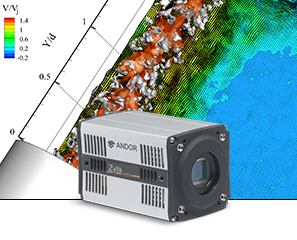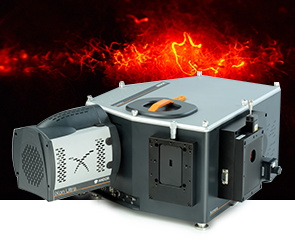生命科学
物理科学
Andor’s portfolio of intensified sCMOS, EMCCD and sCMOS cameras provide a wide range of high sensitivity, fast detection solutions for the fluid, flow and combustion diagnostics ‘home-builder’ Research community. These detectors benefit especially applications in the field of reactive and non-reactive flows, jets and flames, with analysis techniques including:
Andor high sensitivity cameras and modular spectrographs offer a comprehensive range of opto-mechanical interfaces, triggering and acquisition setup options to seamlessly integrate into a wide range of imaging and spectroscopy setups.



PLIF is used for the measurement of concentration/mole fraction of species such as Na, OH, NO, O2, CH, CO or acetone, localised temperature, velocity, and pressure:
Chemiluminescence is an other technique used for flame studies’. It is based on imaging chemically excited (as opposed to laser-excited like LIF/PLIF) species/radicals, e.g. OH*. Chemiluminescence is useful in situations where it is technically difficult or too costly to apply PLIF, e.g. optical engine diagnostics.
2D-PIV provides characterization of flow fields and turbulence dynamics in fluids. It relies on the imaging of light scattered by seeding particles added to the fluid/flow under analysis.
It uses a combination dual-pulse lasers and accurately synchronised detectors capable of dual imaging with extremely short inter-frame (e.g. sCMOS or gated sCMOS) to determine the two velocity components of features of interest in a single plane simultaneously. Variations include:
While CMOS/sCMOS cameras are detector of choice for PIV, gated intensified cameras such as iStar sCMOS can be used to better image (‘freeze’) supersonic flows, further remove strong unwanted background noise and enhance weak signals.
(Rotational) CARS is a non-linear spectroscopy technique used for combustion diagnostics including chemical species identification, species concentration measurement, but also to provide non-invasive map temperatures in combustion engines and flames.
Due to the weak nature of the CARS signal and need for multi-kHz acquisition rates, electron-multiplying EMCCDs are favoured for CARS thermometry
| Author | Title | Year |
| Skiba et al | Premixed flames subjected to extreme levels of turbulence part I: Flame structure and a new measured regime diagram | 2017 |
| Ceglia et al | Experimental investigation on the three-dimensional organization of the flow structures in precessing jets by tomographic PIV | 2017 |
| Payri et al | The effect of nozzle geometry over ignition delay and flame lift-off of reacting direct-injection sprays for three different fuels | 2017 |
| Thomas et al | Femtosecond Chirped-Probe-Pulse Coherent Anti-Stokes Raman Scattering Thermometry of Nitrogen in a Piloted Spray Burner | 2017 |
| Retter et al | Spatially correlated temperature, oxygen, and fuel measurements in a plasma-assisted hydrogen diffusion flame by one-dimensional fs/ps rotational CARS imaging | 2017 |
| Courtney et al | Pure-rotational H2 thermometry by ultrabroadband coherent anti-stokes Raman spectroscopy | 2017 |
| Li et al | Micro-PIV Measurements of Multiphase Flow of Water and Liquid/Supercritical CO2 in 2D Heterogeneous Porous Micromodels | 2016 |
| Richardson et al | Comparison of Chirped-Probe-Pulse Femtosecond and Hybrid Femtosecond/Picosecond CARS for Gas Phase Thermometry | 2016 |
| Ehn et al | Investigations of microwave stimulation of a turbulent low-swirl flame | 2016 |
| Pastor et al | An experimental study of the effects of fuel properties on reactive spray evolution using Primary Reference Fuels | 2016 |
| Hossain et al | A Detailed Experimental and Numerical Investigation of Flow Physics in a Single Row Narrow Impingement Channel Using PIV, LES and RANS | 2016 |
| Smolke et al | Experimental and numerical studies of fuel and hydrodynamic effects on piloted turbulent premixed jet flames | 2016 |
| Kearney et al | Hybrid fs/ps Rotational CARS Temperature and Oxygen Measurements and Soot LII Measurements in a Turbulent C2H4-Fueled Jet Flame | 2016 |
| Okuyama et al | Flame Visualization and Mechanism of Fast Flame Propagation through a Meso-scale Packed Porous Bed in a High-pressure Environment temperature profile | 2015 |
 公安机关备案号31010402003473
公安机关备案号31010402003473